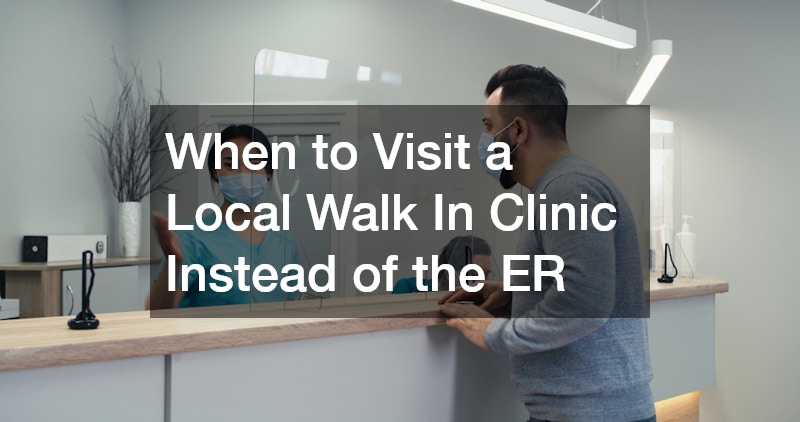

Understanding when to choose a local walk-in clinic over an ER visit can save you time, money, and stress. This article delves into common scenarios where a walk-in clinic is more appropriate than an emergency room. By making informed choices, patients can better navigate the complexities of healthcare while ensuring they receive timely treatment for their ailments.
Minor Injuries and Illnesses
Walk-in clinics are well-suited for treating minor injuries and illnesses such as sprains, minor cuts, and common colds. These facilities are equipped to handle conditions that do not require immediate emergency interventions.
Generally, if the condition does not include severe pain or life-threatening symptoms, a walk-in clinic can be a practical option.
Many people utilize walk-in clinics for non-urgent care, allowing them to avoid the long waits common at emergency rooms. The healthcare providers at these clinics are trained to diagnose and manage a wide range of ailments quickly and efficiently. Furthermore, visiting a walk-in clinic often results in a more personalized care experience due to typically fewer patients.
Vaccinations and Routine Screenings
Walk-in clinics provide a variety of preventative services, including vaccinations and routine health screenings. This makes them an ideal choice for patients who require seasonal flu shots or travel-related vaccinations. Additionally, walk-in clinics often offer cholesterol checks, blood pressure screenings, and other routine monitoring services.
These preventative health services are essential for maintaining long-term health and can be conveniently accessed without scheduling delays. As healthcare becomes increasingly preventive-focused, the role of walk-in clinics in providing these services continues to grow. Many patients find it more convenient to address these routine needs at a walk-in clinic rather than a traditional doctor’s office.
Availability of Diagnostic Services
Many local walk in clinics come equipped with on-site diagnostic tools, including X-rays and basic laboratory testing. These resources enable healthcare providers to quickly assess a patient’s condition and initiate treatment. Having access to diagnostic services within the clinic eliminates unnecessary delays in receiving care.
Patients can expect to undergo diagnostic evaluations for conditions such as fractures or infections at these facilities. The availability of convenient diagnostic services is particularly advantageous for patients needing prompt assessments. This streamlining of the diagnostic process is yet another reason why walk-in clinics serve as an effective intermediary between primary care and emergency room services.
Cost Advantages of Walk-In Clinics
Choosing a walk-in clinic for non-emergency conditions can significantly reduce healthcare expenses. The cost of services at these clinics is typically lower than that of emergency room visits. By opting for walk-in clinics, patients can avoid the higher fees associated with ER treatment while still receiving necessary care.
The financial advantages of walk-in clinics extend to both insured and uninsured patients, as these facilities often offer transparent pricing structures. Many clinics maintain a list of flat-rate fees for various services, making it easier for patients to understand their expenses upfront. This pricing model supports informed decision-making and helps prevent unexpected medical bills.
Wait Time Considerations
One of the most significant advantages of walk-in clinics is the reduced wait time compared to emergency rooms. Patients seeking non-emergency treatment frequently experience shorter wait times, allowing for quicker access to care. This efficiency can be crucial in relieving patient discomfort and starting treatment promptly.
Unlike emergency rooms, which prioritize patients based on the severity of their conditions, walk-in clinics often see patients on a first-come, first-served basis. This system generally results in a more predictable wait time environment. Many walk-in clinics strive to see and treat patients within one hour, providing faster healthcare solutions.
Insurance and Payment Options
Walk-in clinics usually accept a broad range of insurance plans, making them accessible to many patients seeking care. Whether you have private insurance or are covered by government programs like Medicare or Medicaid, chances are a local walk-in clinic will accept your plan. This flexibility helps patients utilize their insurance benefits optimally.
For those without insurance, walk-in clinics often offer affordable payment options. Many clinics provide transparent pricing, allowing patients to understand their financial obligations before receiving care. This approach reduces the financial strain on uninsured individuals and ensures they can access necessary healthcare services.
Emergency Situations That Require Specialized Care
Emergency rooms are equipped with specialized medical resources and personnel to handle complex and life-threatening situations. These facilities provide access to advanced diagnostic tools, surgical capabilities, and specialized medical teams. In cases of severe trauma, stroke, heart attack, or other critical conditions, the ER is the appropriate destination.
Walk-in clinics lack the medical infrastructure to manage emergencies that require advanced interventions. ERs are staffed with specialists trained in emergency medicine, allowing for comprehensive management of critical cases. Their ability to coordinate care with specialists and offer immediate surgical interventions underscores the necessity of choosing the ER.
Outcomes and Follow-Up Care
The aftermath of an emergency room visit often involves follow-up care to ensure recovery and address any ongoing health issues. This aspect of post-emergency care highlights the necessity of using the ER when appropriate. Ensuring proper follow-up can help prevent future complications and promote better health management.
In summary, knowing the difference between when to visit a local walk in clinic and when to opt for the emergency room can improve healthcare efficiency and patient outcomes. Always consider the severity of your condition and local healthcare resources. By choosing the appropriate level of care, patients can optimize their health management strategies and ensure timely access to essential medical services.



